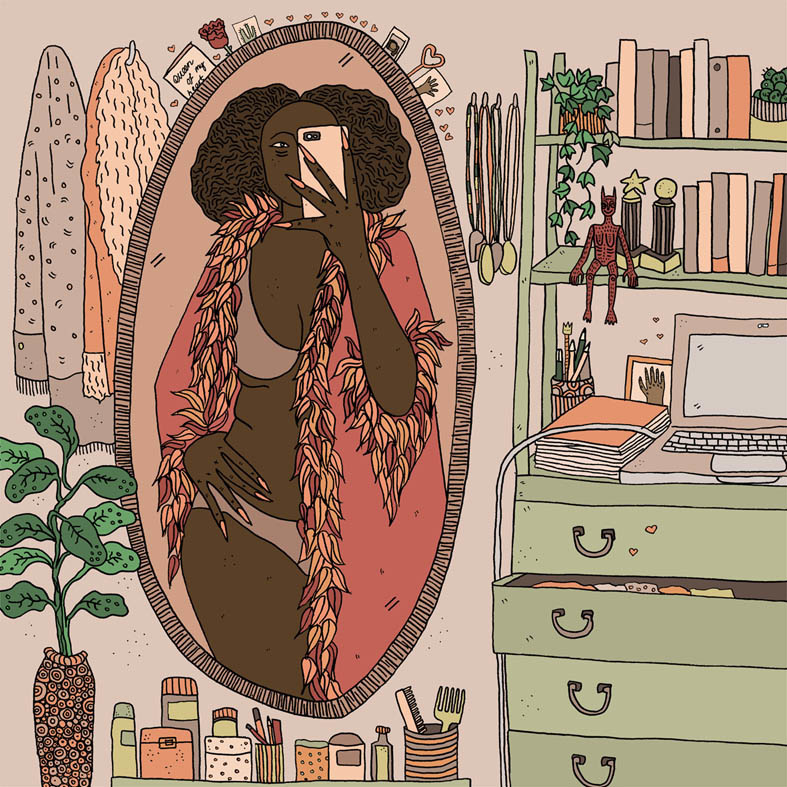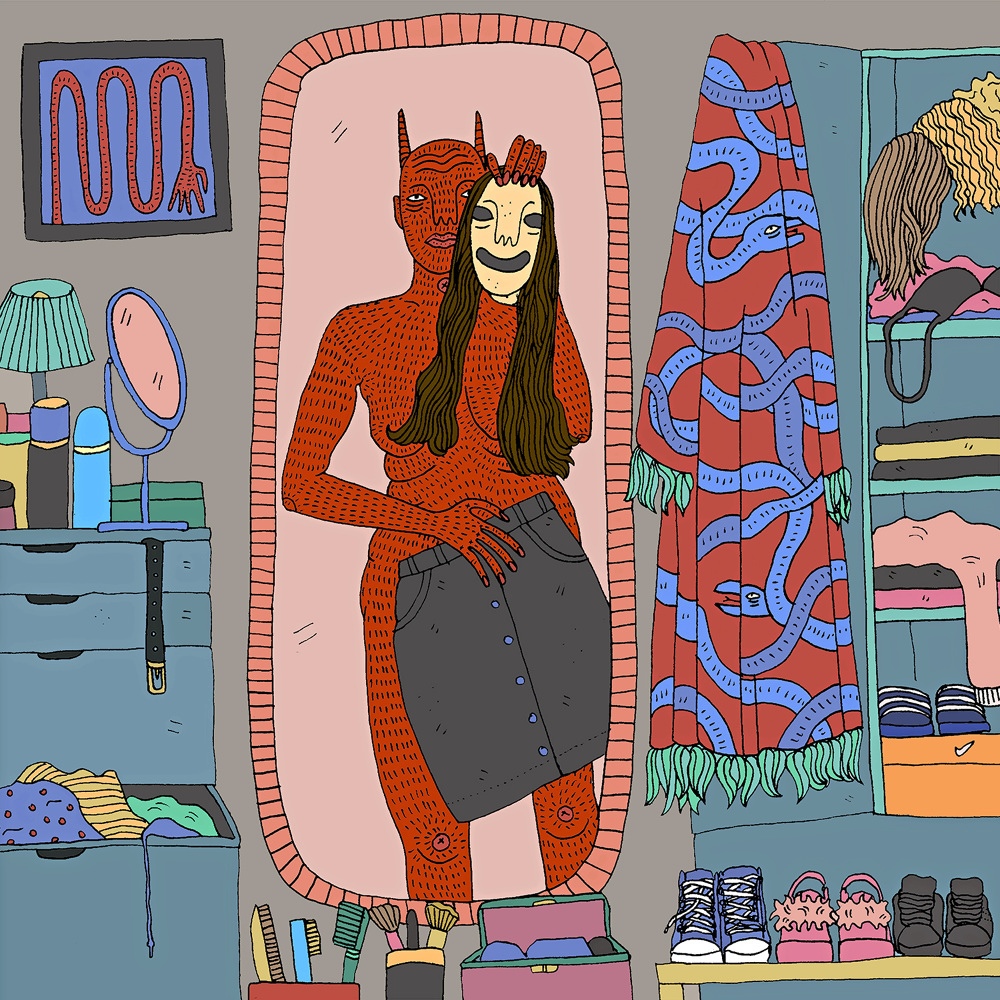Polly Nor is a female illustrator from northwest London best known for her colorful drawings of women and devils in various states of both physical and spiritual undress. Her work provides a much-needed humorous look at sexuality and the female experience in the internet age. Nor herself has been slowly amassing followers and fame via social media, since her illustrations started doing the rounds in the form of memes. Although she initially worried about the fact that her work was going viral uncredited, its ‘meme-ability’ has worked out for her: she has nearly 400k followers on Instagram, has set up an online store, and recently collaborated with Andy Baker to create an animated music video. Nor is currently illustrating a book for Bloomsbury Publishing, and a soon-to-be-announced fashion collaboration as well working towards her next solo exhibition. We met her to find out more.
What is your creative process?
I sit down and try to visualize the way I am feeling and whatever is on my mind at that moment in time. I usually map out the basic shape of my characters in pencil, then I draw out the whole image in pen, scan, and then color digitally.
How would you describe your aesthetic?
I like to use a lot of color in my work — I tend to stick to pastel hues or bright greens and then I use a lot of red for the devils. I often draw from popular culture and the references I make are usually quite lowbrow. It’s kind of surrealist — I have very vivid dreams and most days I wake up feeling exhausted because of all the weird shit I’ve been thinking about all night. I like to bring that into my work by creating scenes that contrast everyday scenes with illogical and sometimes unnerving situations.
What are the three main emotions that inspire your work?
Frustration, anxiety, and sadness. When everything is plain-sailing I find it much harder to create new work.
Something that I really like about your work is the diversity of the girls that you draw. Is that something that you do consciously?
Yeah, that’s a conscious decision. I like to create a real variety of characters. It’s more interesting that way — I like imagining their stories, who they are, what they are thinking, what they are feeling.
Read: This illustrator painted every woman in Wes Anderson’s films.

Who are you inspired by artistically?
I’ve always been really into drawing girls — as a kid I used to draw and paint them everywhere. I really looked up to Miss Van and Fafi, who were both known for their cutesy, sexy graffiti female characters. It isn’t really my cup of tea now, but back then I was obsessed. Studying Frida Kahlo’s work at school definitely inspired me to draw from my own experiences in my art. These days I’m a big fan of Nina Chanel Abney, Andy Baker, Monika Kim Garza, Celeste Mountjoy, Chris The Simpsons Artist, Juno Calypso, Brecht Vandenbrouke, Tschabalala Self, and Claudia Maté.
What do the devils in your work represent?
For me they are a figment of the character’s imagination. I use them to represent the inner turmoil of the female character — a devilish representation of her frustrations, anxieties, and her desires.
Their meaning is ambiguous and can change from one illustration to another. You can’t tell if the devil is the real person or the girl — a bad person with good intentions or a good person with a bad side. Is this dichotomy something that informs your work?
I think we are all capable of containing these thoughts and contradictions to some degree. I’m interested in this exploration of identity. A lot of my work is inspired by the way young people use social media as a performance of our self. Through alternative screen names, filtered selfies, and carefully selected highlights of our relationships, we build a kind of parallel identity of our ideal selves. I draw a lot of inspiration from this and the anxiety behind it. I want to focus on the parts of ourselves that we instead choose to hide from the internet: the dirty, chaotic, imperfect parts of ourselves that make us human.

I feel like self-love is an important theme in your work: both in relation to masturbation (in The Devil Wears Nada) and acceptance and intimacy (in Don’t Care What They Think). Can you tell us a bit more about this?
I think in our culture, female sexuality is still very overlooked. Through mainstream media, women are constantly told how to be sexual, how to look sexually attractive, how to perform sexually, how to please others sexually, but very rarely is there any focus on how we actually feel, what we want, our fantasies. So it is important for me to focus on the thoughts and desires of the characters in my work instead focusing of how sexually attractive she appears to the viewer. I like to draw my characters home alone with nobody around to judge — when they are finally able to release the impulsive, self-serving side of themselves and satisfy their own basic urges and needs with no regard for anybody else.
What do you think are the best and worst things about being an artist in London right now?
London was a cool place to grow up and it’s definitely still an exciting place to be, but it’s getting so expensive to live in — unless you come from a well-off family or are able to live at your parents’ house throughout your twenties, it can be hard to survive here. A lot of my friends are considering moving out of London now because of it.
What does it feel like to have people tattooing your work onto themselves?
It’s really cool that people connect with my drawings enough to get them tattooed — it’s the biggest compliment. There have been so many recently I can’t even put them all up on my Instagram anymore! My mom says she can’t wait to see one one of my devils on E4’s Tattoo Fixers one day.
What are you looking to achieve this year?
Chill the fuck out! The past few years have been great but crazy busy. I’m always working or thinking about work which is actually very unnatural to me as I have always been an incredibly lazy person. I put automatic out of office on most of the time and have turned my notifications off on my phone. I’m also trying to not go online after 10pm although I have definitely failed at that every single night.
Credits
Text Niloufar Haidari
